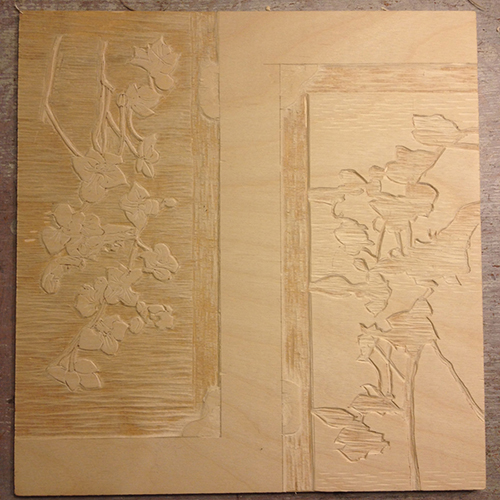A few months ago a friend invited us to the Ashmolean Museum in Oxford to see the Andy Warhol's private collection: 'Works from the Hall Collection’ to be shown to the public for the first time. I love Andy Warhol's prolific and revolutionary work, and not long before the invitation, I had made a note of another exhibition that was showing at the Ashmolean. 'Scenes of Last Tokyo' - A collection of Japanese Creative Prints (Sosaku Hanga) from 1945. We booked a date and made the trip to the museum.
Andy Warhol
We enter the Ashmolean Museum and head for Andy Warhol. Bright vibrant pop splashed screen prints of flowers and well known celebrities adorn the walls, and in another darkened room, black and white cutting edge films in their time play on continuous loop (Empire (1964) Sleep (1963) Eat (1963), Kiss (1963) and Screen Tests (1964-65). We continue into a room of line drawings followed by a room dedicated to silk screen paintings in black and white with a religious and existential theme. And near the exit, a wall of abstract Oxidation prints made from the chemical reaction of urine and copper based paints.
Scenes of Last Tokyo
I head to the exit, down the stairs to the Asian Crossroads Orientation Gallery. Photography is not permitted here so I am unable to show these beautiful colour prints in my journal. I slowly follow the line of fifteen nostalgic views from the 'Akamon' Gate of Imperial University by Maido Masao, 'Asakusa Kwanmon' temple by Saito Kiyoshi, 'Zōjō-ji' by Yamaguchi Gen, to the 'Benkei-bashi' bridge by Senkino Jun’ichiro.
Sosaku Hanga (Creative Prints)
All fifteen woodblock prints were created by nine artists from the Japan Print Association (Nihon Hanga Kiyokai). These prints are not as precise and intricate as woodblock prints from 'Ukiyo-e Pictures of The Floating World'. The lines are loose and expressive. Perfect registration is not essential as one colour bleeds over the edge of the next. These artists would have designed, carved, and printed the blocks themselves allowing more room for exploration and creative freedom. Only twenty years later and Andy Warhol is following Ukiyo-e's traditional system of mass production, employing assistants to print his designs.
Artist's Books
Behind a glass cabinet opposite the woodblock prints lie a collection of ten print albums published by Aoi Shobō. Each book contains ten prints accompanied by poems or essays by the artists. It's a privilege to see this work and I wonder if or where it will travel to next. I make a note of the contact details for Jameel Centre for Islamic and Eastern Art study room and leave the gallery.
'Scenes of Last Tokyo' exhibition continues until 5 Jun 2016.
Tea House & Netsuke
I find my way to West meets East Orientation Gallery. As I enter the room, I encounter a similar experience when I made my first visit to the British Museum's Japanese Galleries. A spacious and serene tea house with tatami mats and paper walls welcomes me into the gallery. I continue into the gallery and find myself in Japan between 1600-1870. Japanese woodblock prints are dotted along the walls and glass cabinets display lacquer boxes. A folded screen is painted with soft yellow flowers in lush green landscape on blue sea. A carp is painted on a silk scroll. There are stoneware and earthenware ceramics, Kakiemon porcelain and a cabinet of netsuke.
Netsuke - Mouse Signed Kanō Tomokazu
A small wooden mouse with its tail curled under its grasping paws looks up at a monkey, a tiger and a bird of prey all hanging from their own seal baskets (inrō).
Inrō
“Since the traditional Japanese garment (Kimono) did not include pockets, other means were carried around to carry around items of daily use. This varied from using the often-capacious sleeves of the kimono, to tucking articles into breast folds. It was the sash (obi), however, which was secured around the waist and used to hold the kimono together, that became the focal point for carrying objects - various pouches, containers,or miscellaneous items , known collectively as sagemono (‘hanging things’) were suspended from the sash - most notable of these were the money pouch - smoking accessories - tobacco box, pipe and pipecase and in particular, the inrō (‘seal basket’).”
Netsuke - Monkey Grooming Unsigned
Netsuke - Tiger Signed Kajikawa Saku
Netsuke - Bird of Prey Signed Moei (Nakaōji Moei)
Netsuke donated to Ashmolean by Sir Herbert and Lady Ingram
Do What You Love
I think about the time, dedication and discipline needed to the make these tiny objects and am reminded of Motoharu Asaka's precise and intricate carvings for traditional Japanese woodblock prints. There is no doubt that spending so many years full time as an apprentice to any craft produces absolute mastery of one's discipline but what resonates for me even more is the passion and dedication to doing what you love. This is so evident in the work of Andy Warhol and the Sosaku Hanga artists who immersed themselves deeply into their passion creating such a prolific and exciting body of work.
“The seeds of tomorrow’s brilliance are planted in the soil of today’s activity. If you want to do great work in five years, that begins today. As Gretchen Rubin put it, “What you do every day matters more than what you do once in a while.”
We leave the museum and follow a path to the river lined with narrow boats and ducklings. The sun is still shining. We sit on a bench and watch the rowers race by.












